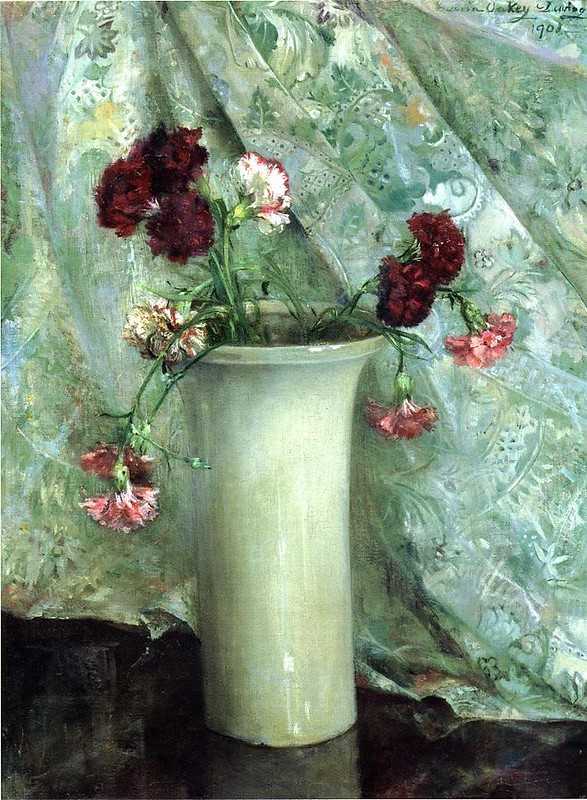I have published many children’s poems from nineteenth century magazines here at The New Leaf Journal. I came across a new poem to share from the August 29, 1882 issue of Harper’s Young People – Mrs. T.W. Dewing’s The Dancing Goat. But before reprinting the poem with its original picture – let us discern the identity of Mrs. T.W. Dewing.
Who is Mrs. T.W. Dewing?
When I come across a poem in an old magazine, the first thing I do is look up the poet. In some cases the poet is well known. In other cases there is no extant information about the poet at all. The name “T.W. Dewing” is well-known to many art historians. However, I started my inquiry from zero.
The first result on DuckDuckGo for T.W. Dewing was a page for Thomas Wilmer Dewing at the Smithsonian Art Museum. Thomas Dewing, one of the preeminent figure painters of his time, lived from 1851-1938. However, the author of the poem was not Mr. T.W. Dewing, but Mrs. T.W. Dewing. While this was enough to point to his wife being the author of the poem in question, I did not know whether the article would have any information about her. Fortunately, the end of his profile page at the Smithsonian Art Museum had the information I was looking for:
He moved in 1880 and on Christmas Day of that year proposed to artist Maria Oakey. The young couple embraced New York’s cultural scene, joining a circle of rising artists, actors, musicians, and writers. For more than fifteen years, Thomas and Maria led the artists’ colony at Cornish, New Hampshire, pursuing a “higher life” through art, music, and literature.

Thomas Dewing married a fellow artist named Maria Oakey on 1880, just two years before the publication of Mrs. T.W. Dewing’s The Dancing Goat. While Oakey is described as an artist, Smithsonian notes that the artist colony that she ran with her husband engaged in art, music, and literature.
On Maria Oakey Dewing
Maria Oakey Dewing was a prominent artist in her own right – so much so that she also has a page on the Smithsonian Art Museum website. She lived from 1845-1927.
Smithsonian explains that Maria Oakey Dewing was taken seriously as an artist early in her career, and that she also published articles and books on etiquette and housekeeping (she published art books later in her career). After marrying Thomas Dewing, Maria shifted from figure painting to painting flowers – for which she is now most well-known . Smithsonian states that she felt unable to compete with her husband, who was among the most prestigious figure painters of the day (or of all time, as stated by The Surovek Gallery). On the subject of flower painting, Maria Dewing wrote the following in 1915 (courtesy of Crystal Bridges Museum of American Art):
The flower offers a removed beauty that exists only for beauty, more abstract than it can be in the human being, even more exquisite. One may begin with the human figure at the logical and realistic, but in painting the flower one must even begin at the exquisite and distinguished.
Maria Oakey Dewing (1915)

According to Smithsonian, Maria Dewing fretted in her later life that she had accomplished nothing. I think that the number of articles about her on the websites of the Smithsonian and other preeminent American art museums nearly one century after her death indicate that her concerns were happily unfounded.
A Clue About Dewing’s Poem
I am confident (just short of certain) that Maria Oakey Dewing authored the children’s poem that prompted this article. However, none of the art museum profiles indicate that she ever engaged in creative writing, much less children’s poetry. Mysterious. I decided to check another, oft-used resource, to see if I could find any clues.
I turned to Wikipedia – which unsurprisingly has a page for Maria Oakey Dewing. Her Wikipedia page has a section on her writing, but there is no mention of her writing poetry. However, there is one interesting clue that relates to where I found her 1882 poem. Two of Maria Dewing’s books were published by Harper & Brothers in 1881 and 1882, respectively. Harper & Brothers was (shockingly) the publisher of Harper’s Young People.
Was there a connection between Maria Oakey Dewing’s submitting a poem to Harper’s Young People and her working with the magazine to publish books at the same time? I cannot say for sure, but in light of the fact that I found no evidence that she regularly (or ever) published poetry outside of this one case, it seems likely to me that there is some connection.
The Poem Introduction
Having identified Maria Oakey Dewing as the poet, we now turn to her poem – a short charming piece about an Italian boy and a dancing goat. I see no connection between the poem and her other work, but perhaps a Maria Oakey Dewing scholar out there may be able to shed more light on it for us.
“The Dancing Goat” by Maria Oakey Dewing


See! This Italian boy, Much to the children's joy. Has taught his goat With the furry coat To caper and prance To the tune of a dance, While he will play All a summer's day On his mandolin His bread to win. At night he'll lie 'Neath the open sky, With the grass for bed, And beneath his head For pillow the goat With the furry coat, And sleep till day, When again he'll play On his mandolin His bread to win.